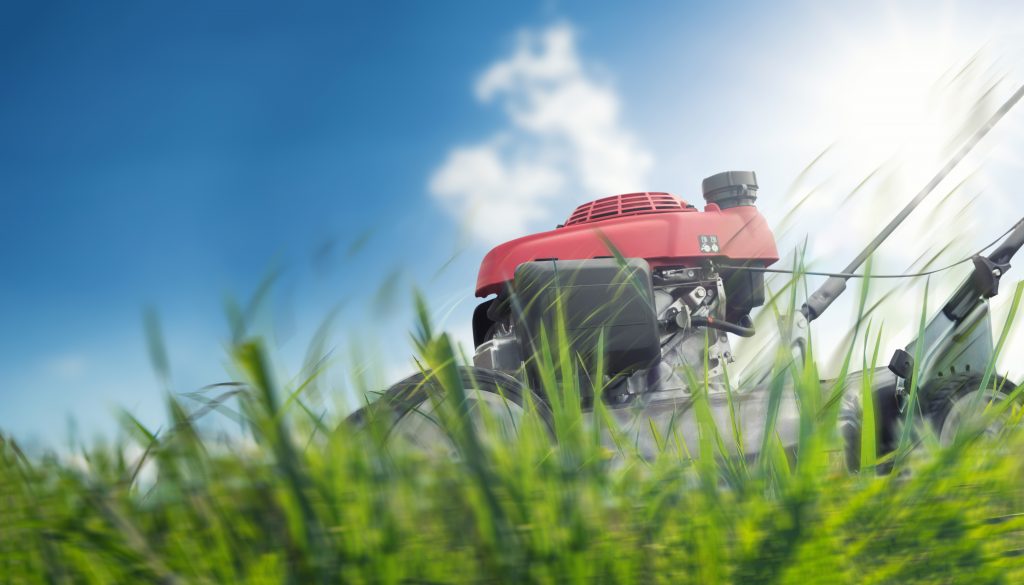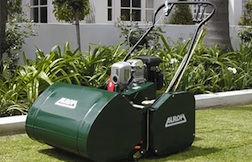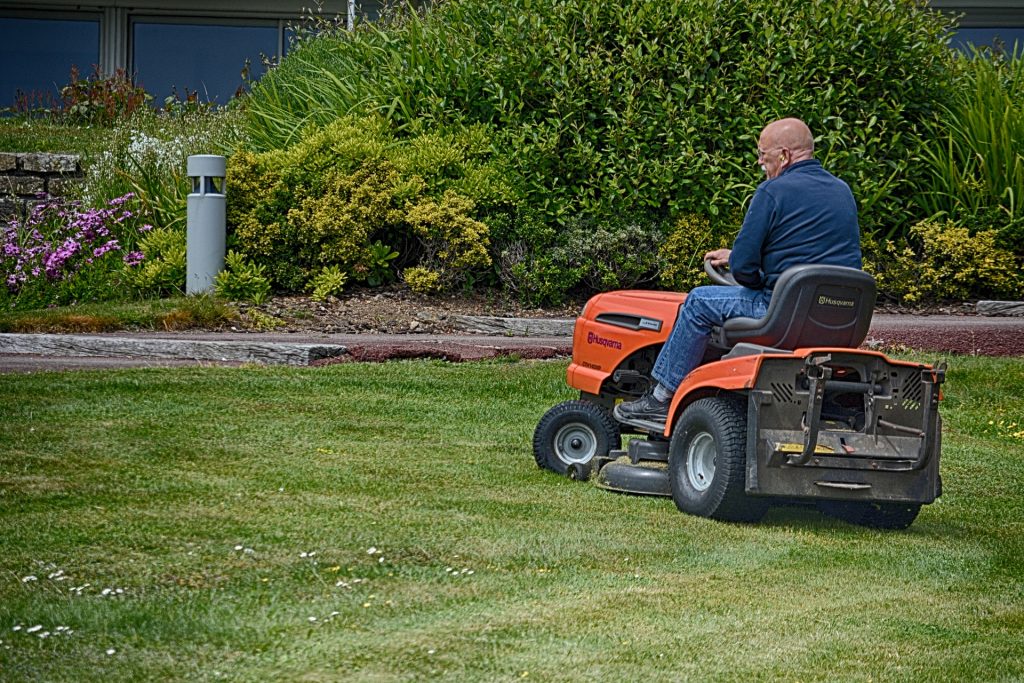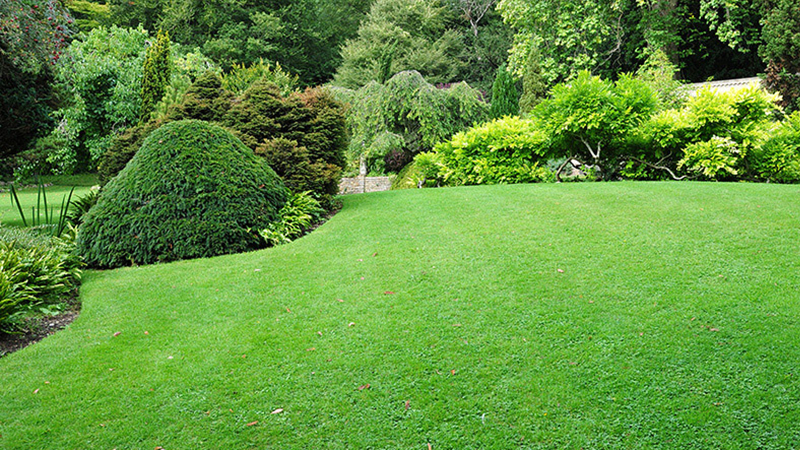Can a Lawn Mower Spread Fungus?
A beautiful green lawn is a natural invitation to relax, play and spend time outdoors. However, ensuring your lawn stays healthy requires effort and a lawn care routine, ...

In this complete guide, you will find out all you ever need to know before buying a lawnmower.
 When buying a mower, it’s important to first have a look at your yard size and the terrain.
When buying a mower, it’s important to first have a look at your yard size and the terrain.
The main elements to consider when buying a lawn mower are:
Below is a breakdown of each element you need to take into account when choosing the perfect lawn mower.
 Before purchasing a mower the first question you should ask is, what size is my lawn?
Before purchasing a mower the first question you should ask is, what size is my lawn?
Most push mowers are suitable for an acre, which is about 13,277 square metres, anything above this size will see you, most likely, wanting to purchase a ride-on mower.
So before making the big decision as to which mower, think realistically about how much time you have to mow your lawn on a busy weekend and select your equipment accordingly.
Your property size does impact how long it takes to mow your lawn and larger lawns require more mowing time for obvious reasons.
 The size of the mower deck impacts how long it will take to mow your lawn.
The size of the mower deck impacts how long it will take to mow your lawn.
A larger deck allows the mower to cut a larger strip of lawn in one single pass, meaning the lawn is mown in less time.
Larger mowers also have longer blades which require a larger engine and are typically more expensive.
Some lawn mowers are designed to cut at a faster pace.
The size of your mower’s engine greatly influences how fast it moves and how fast the blades can spin.
It is always important to have sharp blades and to not push your mower by going too fast in order to get an even cut and avoid damaging your lawn.
The average speed of residential lawn mowers
Mower Type |
Speed (MPH) |
| Push Mowers | 3 MPH |
| Battery Mowers | 2.5 MPH |
| Ride-on Mowers | 3-5 MPH |
| Zero-Turn Mowers | 5-8 MPH |
Your lawn’s conditions greatly impact how long it will take to mow.
A yard with many curves, trees, hills, walls, and other obstacles will take much longer to mow than a square yard with no obstacles. It’s difficult to predict exactly how long these obstacles will slow mowing time, but keep in mind that the more there are the longer it will take. Muddy or overgrown patches of lawn can also take longer to mow or workaround.
 Generally, a push mower is a good choice for yards that are about 3/4 of an acre or less.
Generally, a push mower is a good choice for yards that are about 3/4 of an acre or less.
The smaller your yard, the smaller the mower deck can be – which is the actual width the mower will cut in a single pass.
0-100m2 yard is best suited with a 16-inch push mower and up (1 push = 16 inches).
100m2-200m2 yard is best suited with a 18-inch push mower and up.
Greater than 300m2 is best suited with a 19-21-inch push mower.
Larger lawns over 500m2 are best suited with a ride-on mower such as a rear-engine riding mower or a lawn and garden tractor.
Ride-on mowers with rear-mounted engines provide good visibility and excellent mobility around trees, flowerbeds and other landscape features. Ride-on mowers are available with mowing decks that range from 28-42 inches wide and engines from 12-20 hp.
Yards in the 1-3 acre range are best suited with a zero-turning ride-on or front engine lawn tractor with at least 14-16 hp and a wide mowing deck – at least 38 inches.
Yards larger than 3 acres are best suited with a larger zero-turn rider or a garden tractor. Look for mowers that have at least 18hp engines and mowing decks in the 44-54 inch range.
 It is also important to consider the type of grass you have in your yard when considering purchasing a mower.
It is also important to consider the type of grass you have in your yard when considering purchasing a mower.
The most common lawns are Couch, Zoysia, Buffalo and Kikuyu.
Couch Turf – requires less horsepower to drive the mower as the cut is not as thick, potentially use smaller 140CC (cubic centimeter) engine.
Zoysia Turf– requires less horsepower to drive the mower as the cut is not as thick, potentially use smaller 150CC (cubic centimeter) engine.
Buffalo and Kikuyu Turf – both types of grass require greater horsepower to drive the mower as they are thicker, potentially use 150 + CC (cubic centimeter) engine.
 There are many different lawn mowers on the market to meet a variety of lawn mowing needs.
There are many different lawn mowers on the market to meet a variety of lawn mowing needs.
A mower that is perfect for your neighbour may not be the right one for you.
Push mowers are ideal for flat yards and range in deck sizes depending on the size of your lawn.
Remember, the larger the deck of the push mower the heavier the mower is to push. A push mower cutting deck can range from 16-22 inches which is the ideal size to mow your lawn beautifully efficiently and quickly.
 Cylinder lawn mowers have cylindrical blades that rotate vertically at the front of the mower.
Cylinder lawn mowers have cylindrical blades that rotate vertically at the front of the mower.
Cylinder lawn mowers cut against a fixed blade at the bottom and they should have multiple blades – three or more is best.
Cylinder lawn mowers are best for flat lawns that you want to keep short and well-manicured.
All cylinder mowers have a rear roller to give the best ‘striped effect’ across your mown lawn. Cylinder mowers come with a grass box that attaches to the machine and collects the grass clippings as you mow. Cylinder lawn mowers can be electric, petrol-powered and push mowers.
Rotary lawn mowers have a single blade that rotates horizontally underneath the mower, like a plane’s propellers. Rotary lawn mowers are the most versatile type, will cope with most types of grass and are therefore better than cylinder mowers at cutting longer and rougher grasses.
A rotary mower may be electric, battery or a petrol engine.
Hover lawn mowers hover above the ground, making them easier to push and adept at mowing uneven surfaces. Hover mowers are a good choice for unusual-shaped lawns and cheaper than other types. Hover lawn mowers are not always suitable for large lawns, are usually electric powered and have rotary blades.
 Self-propelled mowers are ideal for larger yards, ranging between ¼ and ¾ acre, as the mower pushes itself to reduce the fatigue of the person mowing the lawn. The user walks behind the self-propelled mower to control its path.
Self-propelled mowers are ideal for larger yards, ranging between ¼ and ¾ acre, as the mower pushes itself to reduce the fatigue of the person mowing the lawn. The user walks behind the self-propelled mower to control its path.
Self-propelled lawn mowers offer both front and rear wheel drive depending on your yard’s needs.
Front drive pushers are ideal for smaller yards with many obstacles as the front wheels swivel by allowing easy 180-degree turns.
Rear wheel drive mowers are ideal for hills due to their traction and have better steering control but can be harder to navigate sharp turns. Rear wheel drive mowers are better suited to open yards with steep hills.
 Bagging is a technique used to catch cut grass and mowers are available with both rear and side bags that produce a fresh-looking lawn every time you mow.
Bagging is a technique used to catch cut grass and mowers are available with both rear and side bags that produce a fresh-looking lawn every time you mow.
Rear bagging mowers give you more manoeuvrability around obstacles throughout your yard.
Mulching mowers have mulching blades that cut the grass into fine pieces and return them to your lawn to act as a natural fertiliser. A mulching mower works to improve your lawn’s health and does not require any extra time or money. A mulching mower also removes the time you may spend emptying the grass out of a bagging mower.
If your lawn size is larger than ¾ acre than consider a ride-on mower.
Lawn size |
Mower size and type |
Price guide |
|
Small lawn ( up to 100 sq meters) |
Battery or petrol lawn mowers |
$150 – $1800 (price depends on accessories associated with the battery lawn mower) |
|
Medium lawn (100 – 250 sq meters) |
Battery or petrol lawn mowers |
$150 – $1800 (price depends on accessories associated with the battery lawn mower) |
|
Large lawn (250 plus sq meters) |
Petrol lawn mowers |
$200 – $2800 |
 The size and selection of your ride-on mower is greatly a budget-related choice. The big difference between cheap mowers and expensive mowers are the fabricated decks, and most mower users would be best suited to a deck with thickness – to about 7-11-gauge.
The size and selection of your ride-on mower is greatly a budget-related choice. The big difference between cheap mowers and expensive mowers are the fabricated decks, and most mower users would be best suited to a deck with thickness – to about 7-11-gauge.
The way people mow their lawns in Australia means scalping often occurs, which is when the blades are moving along the ground, causing a lot of pressure to be placed on the blades. Therefore, a cheaper press metal deck ride-on mower flexes and wears out quickly meaning they need replacing more often than fabricated ride-on deck mowers.
Important – if you have a large acreage block, such as 5 plus acres, you should consider a mid-range, stronger mower deck.
Most ride-on mowers resemble a small tractor with a cutting deck suspended underneath, and they cut a wide strip of grass – anywhere from 70cm to over a metre.
A general rule of thumb is to note that ride-on lawnmowers are convenient and best suited for lawns over one acre in size. Ride-on mower prices can start at around $3000, so if your property size is around ½ to 1 acre, you might want to instead consider a push mower which could save you thousands. But for lawns larger than 1 acre, the convenience of a ride-on mower should be considered.
There is a wide range of ride-on mowers on the market, and the top brands offer class-leading cutting widths, power figures and extra features, but be prepared to pay.
There are three main types of ride-on lawnmowers:
Rear-engine ride-on mowers are generally quite basic and cheaper. Rear-engine mowers often feature power levels similar to high-end push mowers, and offer the same versatility, except you sit on them. Rear engine mowers usually feature smaller chassis and cutting widths, making them ideal for smaller lawns and driving through tight spaces, such as gates and fences.
However, rear-engine ride-on mowers can lack the power of other ride-on types but, the convenience factor and small frame may make it worthwhile for lawns that aren’t too big.
 Lawn and garden ride-on mowers have their engine at the front and their grass dispersed to the side.
Lawn and garden ride-on mowers have their engine at the front and their grass dispersed to the side.
In Australia, lawn and garden ride-on mowers are very popular for lawns that are over 1 acre.
Compared to rear-engine mowers, lawn and garden mowers often have more engine power, with much wider cutting widths of 70cm making them ideal for larger yards.
Lawn ride-on mowers are generally the smaller of the two, while garden varieties are bigger, have more power, larger cutting widths and look like a tractor more than a mower.
 If your lawn is of a reasonably large acreage with many obstacles, then consider a zero-turn ride-on mower.
If your lawn is of a reasonably large acreage with many obstacles, then consider a zero-turn ride-on mower.
Zero-turn mowers have a rear-mounted engine and rear-wheel-brake steering, that delivers a very tight turning circle.
First time users of zero-turn mowers will need a bit of practice to get the feel of using lever steering controls.
One of the stand-out features of zero-turn mowers is the super-tight turning circles it can do, with the ability to make a 360° turn. Most zero-turn mowers feature large cutting widths of 100cm or more, making easy, short work of your lawn.
Zero-turn mowers also feature higher top speeds, with a lightweight frame and comparatively high-power engine figures. However, zero-turn mowers are somewhat of a premium compared to other mowers and best suited to manicuring elaborate lawns. Suburban homeowners with smaller yards may not see much use in a zero-turn mower.
Once you decide what sort of ride-on mower you would like for your lawn and yard you may want to consider some of the features that can make your mowing experience easier.
Many mowers catch or send lawn clippings through an on-board mulcher to allow for easy grass recycling. Mowers without catchers or mulching features aren’t necessarily worse-off, it all comes down to what the user prefers.
Catching on mowers can work better on smaller lawns where reaching ‘fill’ capacity is not much of an issue. Mulching mowers are generally more efficient for large yards with finer grasses, such as Zoysia or Couch, while discharging works better for coarse grasses, such as Buffalo and Kikuyu.
As with cars, automatic transmissions on mowers are much easier to use however manual transmissions are still often cheaper. So, ask yourself if it is worth saving the extra money for the extra hassle of having to change gears on a manual transmission mower?
 The weight of your ride-on mower is very important as this can affect the performance and manoeuvrability of your mower which can weigh in excess of 100kg, and with a rider on top can skew the centre of gravity.
The weight of your ride-on mower is very important as this can affect the performance and manoeuvrability of your mower which can weigh in excess of 100kg, and with a rider on top can skew the centre of gravity.
If your yard and lawn is sloped, a zero-turn mower will sit lower and therefore has a lower centre of gravity, making it safer to cross hills and uneven terrain
For maximum mower stability on sloped surfaces, an all-wheel drive model is an option, but they do cost more – however, when it comes to mowing on difficult terrain safety should come first!
Lawn size |
Mower size and type |
Price guide |
|
Up to 1 acre |
Lawn ride-on with 30-42 inch cutting width
Zero-turn ride-on mower with 42 inch cutting width |
$2000 – $5000 |
|
Up to 2 acres |
Lawn ride-on with 46-48 inch cutting width
Zero-turn ride-on mower with 46-48 inch cutting width |
$3000 – $7000 |
|
More than 2 acres |
Lawn ride-on with 50 inch or bigger cutting width
Zero-turn ride-on mower with 50-60 inch cutting width |
$7000 – $15,000 |
When it comes to deciding whether you want a petrol or battery lawn mower it comes down to your yard and your preferences.
For most modern suburban blocks with a small yard, an electric mower is probably ‘good enough’. Electric and/or battery mowers benefit from quieter operation, have no emissions and are commonly cheaper than petrol mowers.
However, petrol mowers win out by their sheer ability to get the job done because they often feature more powerful motors, with leading torque figures and cutting widths. For homeowners living on older, bigger blocks or semi-rurally, a petrol lawn mower is probably still the best option.
 Petrol lawn mowers win-out when it comes to power, with the average petrol mower achieving at least 7nm (newton metre) of torque making mowing the average suburban blocks child’s play.
Petrol lawn mowers win-out when it comes to power, with the average petrol mower achieving at least 7nm (newton metre) of torque making mowing the average suburban blocks child’s play.
The average lawn mower engine sizes are between 150-200cc (cubic centimeters).
With large engine capacities and big torque figures, petrol lawn mowers become the dominant contender for mowing lawn quickly and efficiently.
Battery/electric lawn mowers, on the other hand, are more suited to small blocks and strips of grass. However, any type of push mower is probably going to be a struggle and hard work if you have a large block – that’s when a ride-on mower should be considered.
For no emissions and low noise, an electric lawn mower is the way to go as long as the block suits that size mower
Aside from just noise and smell, petrol lawn mowers are also prone to polluting similar amounts to cars.
 The useability of your lawn mower generally comes down to the individual model in question, rather than what powers the motor.
The useability of your lawn mower generally comes down to the individual model in question, rather than what powers the motor.
Several things to consider with an electric mower:
Is it corded or cordless? Corded lawn mowers provide endless run time, but you are limited by how far the extension cord goes.
While many corded lawn mowers are over 20m, you may still have to unplug and replug as you mow and have outdoor power points around your yard.
Cordless mowers are obviously unbound by cords, but may feature limited run times of an hour or less, making a second battery necessary if tackling anything more than a small lawn. Charging the batteries of a cordless mower also takes longer than how long you can run them for.
If you live on a yard bigger than ¼ acre, a petrol mower with a 50cm plus cutting width is most likely more suitable. Electric mowers are also generally lighter than petrol as they don’t have a mechanical engine on-board.
 No matter the type of mower, they all require some degree of maintenance.
No matter the type of mower, they all require some degree of maintenance.
A petrol lawn mower with its mechanical engine may require more maintenance than an electric mower.
Both electric and petrol lawn mowers require maintaining, sharpening, and oiling the blades, but petrol mowers – like cars – also require extra servicing.
Petrol mowers require spark plugs, oil, air and fuel filters, and of course petrol
Despite the shortcomings of an electric mower, their potentially lower running costs may make the compromise worth it – if your yard is small enough.